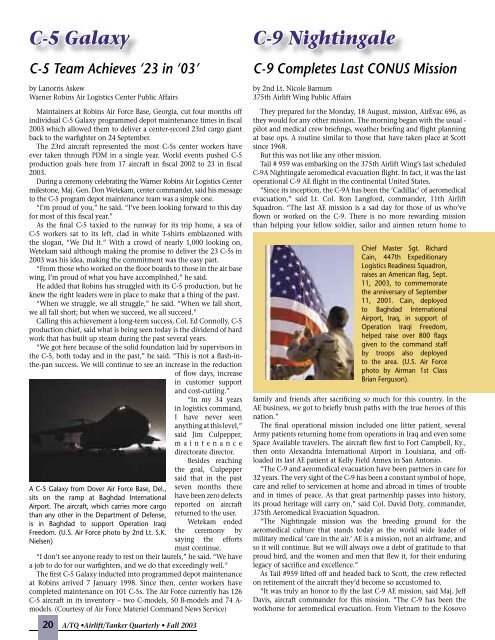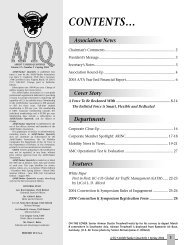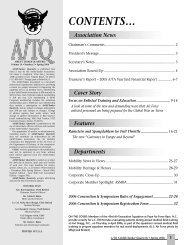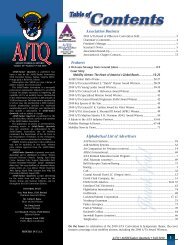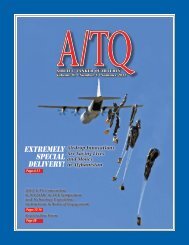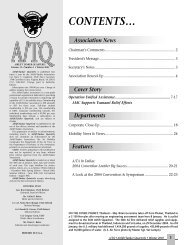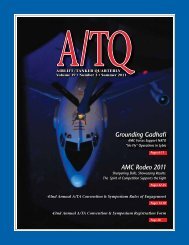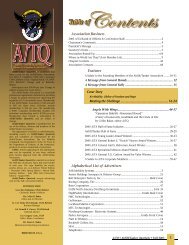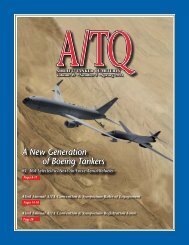1) ATQ Fall 2003 for pdf - Airlift/Tanker Association
1) ATQ Fall 2003 for pdf - Airlift/Tanker Association
1) ATQ Fall 2003 for pdf - Airlift/Tanker Association
Create successful ePaper yourself
Turn your PDF publications into a flip-book with our unique Google optimized e-Paper software.
C-5 Galaxy<br />
C-5 Team Achieves ‘23 in ‘03’<br />
by Lanorris Askew<br />
Warner Robins Air Logistics Center Public Affairs<br />
Maintainers at Robins Air Force Base, Georgia, cut four months off<br />
individual C-5 Galaxy programmed depot maintenance times in fiscal<br />
<strong>2003</strong> which allowed them to deliver a center-record 23rd cargo giant<br />
back to the warfighter on 24 September.<br />
The 23rd aircraft represented the most C-5s center workers have<br />
ever taken through PDM in a single year. World events pushed C-5<br />
production goals here from 17 aircraft in fiscal 2002 to 23 in fiscal<br />
<strong>2003</strong>.<br />
During a ceremony celebrating the Warner Robins Air Logistics Center<br />
milestone, Maj. Gen. Don Wetekam, center commander, said his message<br />
to the C-5 program depot maintenance team was a simple one.<br />
“I’m proud of you,” he said. “I’ve been looking <strong>for</strong>ward to this day<br />
<strong>for</strong> most of this fiscal year.”<br />
As the final C-5 taxied to the runway <strong>for</strong> its trip home, a sea of<br />
C-5 workers sat to its left, clad in white T-shirts emblazoned with<br />
the slogan, “We Did It.” With a crowd of nearly 1,000 looking on,<br />
Wetekam said although making the promise to deliver the 23 C-5s in<br />
<strong>2003</strong> was his idea, making the commitment was the easy part.<br />
“From those who worked on the floor boards to those in the air base<br />
wing, I’m proud of what you have accomplished,” he said.<br />
He added that Robins has struggled with its C-5 production, but he<br />
knew the right leaders were in place to make that a thing of the past.<br />
“When we struggle, we all struggle,” he said. “When we fall short,<br />
we all fall short; but when we succeed, we all succeed.”<br />
Calling this achievement a long-term success, Col. Ed Connolly, C-5<br />
production chief, said what is being seen today is the dividend of hard<br />
work that has built up steam during the past several years.<br />
“We got here because of the solid foundation laid by supervisors in<br />
the C-5, both today and in the past,” he said. “This is not a flash-inthe-pan<br />
success. We will continue to see an increase in the reduction<br />
of flow days, increase<br />
in customer support<br />
and cost-cutting.”<br />
“In my 34 years<br />
in logistics command,<br />
I have never seen<br />
anything at this level,”<br />
said Jim Culpepper,<br />
m a i n t e n a n c e<br />
directorate director.<br />
Besides reaching<br />
the goal, Culpepper<br />
said that in the past<br />
A C-5 Galaxy from Dover Air Force Base, Del.,<br />
sits on the ramp at Baghdad International<br />
Airport. The aircraft, which carries more cargo<br />
than any other in the Department of Defense,<br />
is in Baghdad to support Operation Iraqi<br />
Freedom. (U.S. Air Force photo by 2nd Lt. S.K.<br />
Nielsen)<br />
seven months there<br />
have been zero defects<br />
reported on aircraft<br />
returned to the user.<br />
Wetekam ended<br />
the ceremony by<br />
saying the ef<strong>for</strong>ts<br />
must continue.<br />
“I don’t see anyone ready to rest on their laurels,” he said. “We have<br />
a job to do <strong>for</strong> our warfighters, and we do that exceedingly well.”<br />
The first C-5 Galaxy inducted into programmed depot maintenance<br />
at Robins arrived 7 January 1998. Since then, center workers have<br />
completed maintenance on 101 C-5s. The Air Force currently has 126<br />
C-5 aircraft in its inventory – two C-models, 50 B-models and 74 A-<br />
models. (Courtesy of Air Force Materiel Command News Service)<br />
C-9 Nightingale<br />
C-9 Completes Last CONUS Mission<br />
by 2nd Lt. Nicole Barnum<br />
375th <strong>Airlift</strong> Wing Public Affairs<br />
They prepared <strong>for</strong> the Monday, 18 August, mission, AirEvac 696, as<br />
they would <strong>for</strong> any other mission. The morning began with the usual -<br />
pilot and medical crew briefings, weather briefing and flight planning<br />
at base ops. A routine similar to those that have taken place at Scott<br />
since 1968.<br />
But this was not like any other mission.<br />
Tail # 959 was embarking on the 375th <strong>Airlift</strong> Wing’s last scheduled<br />
C-9A Nightingale aeromedical evacuation flight. In fact, it was the last<br />
operational C-9 AE flight in the continental United States.<br />
“Since its inception, the C-9A has been the ‘Cadillac’ of aeromedical<br />
evacuation,” said Lt. Col. Ron Lang<strong>for</strong>d, commander, 11th <strong>Airlift</strong><br />
Squadron. “The last AE mission is a sad day <strong>for</strong> those of us who’ve<br />
flown or worked on the C-9. There is no more rewarding mission<br />
than helping your fellow soldier, sailor and airmen return home to<br />
Chief Master Sgt. Richard<br />
Cain, 447th Expeditionary<br />
Logistics Readiness Squadron,<br />
raises an American flag, Sept.<br />
11, <strong>2003</strong>, to commemorate<br />
the anniversary of September<br />
11, 2001. Cain, deployed<br />
to Baghdad International<br />
Airport, Iraq, in support of<br />
Operation Iraqi Freedom,<br />
helped raise over 800 flags<br />
given to the command staff<br />
by troops also deployed<br />
to the area. (U.S. Air Force<br />
photo by Airman 1st Class<br />
Brian Ferguson).<br />
family and friends after sacrificing so much <strong>for</strong> this country. In the<br />
AE business, we got to briefly brush paths with the true heroes of this<br />
nation.”<br />
The final operational mission included one litter patient, several<br />
Army patients returning home from operations in Iraq and even some<br />
Space Available travelers. The aircraft flew first to Fort Campbell, Ky.,<br />
then onto Alexandria International Airport in Louisiana, and offloaded<br />
its last AE patient at Kelly Field Annex in San Antonio.<br />
“The C-9 and aeromedical evacuation have been partners in care <strong>for</strong><br />
32 years. The very sight of the C-9 has been a constant symbol of hope,<br />
care and relief to servicemen at home and abroad in times of trouble<br />
and in times of peace. As that great partnership passes into history,<br />
its proud heritage will carry on,” said Col. David Doty, commander,<br />
375th Aeromedical Evacuation Squadron.<br />
“The Nightingale mission was the breeding ground <strong>for</strong> the<br />
aeromedical culture that stands today as the world wide leader of<br />
military medical ‘care in the air.’ AE is a mission, not an airframe, and<br />
so it will continue. But we will always owe a debt of gratitude to that<br />
proud bird, and the women and men that flew it, <strong>for</strong> their enduring<br />
legacy of sacrifice and excellence.”<br />
As Tail #959 lifted off and headed back to Scott, the crew reflected<br />
on retirement of the aircraft they’d become so accustomed to.<br />
“It was truly an honor to fly the last C-9 AE mission, said Maj. Jeff<br />
Davis, aircraft commander <strong>for</strong> this mission. “The C-9 has been the<br />
workhorse <strong>for</strong> aeromedical evacuation. From Vietnam to the Kosovo<br />
20 A/TQ •<strong>Airlift</strong>/<strong>Tanker</strong> Quarterly • <strong>Fall</strong> <strong>2003</strong>


